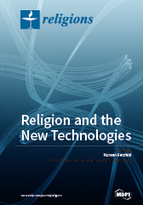Religion and the New Technologies
A special issue of Religions (ISSN 2077-1444).
Deadline for manuscript submissions: closed (1 February 2017) | Viewed by 109793
Special Issue Editor
Special Issue Information
Dear Colleagues,
In 2000, Bill Joy wrote a controversial article in Wired magazine entitled "Why the Future Does not Need Us", in which he called for a moratorium on research in AI, nanotechnology, and genetic manipulation until we have got a better handle on the ethical questions these new technologies would raise. The intervening 15 years since Joy's call have brought significant advances in each of these technologies—Deep Learning, nanobots on the horizon, CRISPER-Cas9 just to name a few. These advances have implications for what it means to be human and how human life will unfold in the coming decades. This Special Issue will explore the religious issues AI, nanotechnology, and genetic modification raise. How do these technologies change our understanding of ourselves, our place in the world, our relationships to one another, our understanding of death, or our relationship to God?
Prof. Dr. Noreen Herzfeld
Guest Editor
Manuscript Submission Information
Manuscripts should be submitted online at www.mdpi.com by registering and logging in to this website. Once you are registered, click here to go to the submission form. Manuscripts can be submitted until the deadline. All papers will be peer-reviewed. Accepted papers will be published continuously in the journal (as soon as accepted) and will be listed together on the special issue website. Research articles, review articles as well as short communications are invited. For planned papers, a title and short abstract (about 100 words) can be sent to the Editorial Office for announcement on this website.
Submitted manuscripts should not have been published previously, nor be under consideration for publication elsewhere (except conference proceedings papers). All manuscripts are thoroughly refereed through a double-blind peer-review process. A guide for authors and other relevant information for submission of manuscripts is available on the Instructions for Authors page. Religions is an international peer-reviewed open access monthly journal published by MDPI.
Please visit the Instructions for Authors page before submitting a manuscript. Submitted papers should be well formatted and use good English. Authors may use MDPI's English editing service prior to publication or during author revisions.
Keywords
- artificial intelligence
- transhumanism
- posthumanism
- biotechnology
- nanotechnology
- robots
- genetic manipulation






